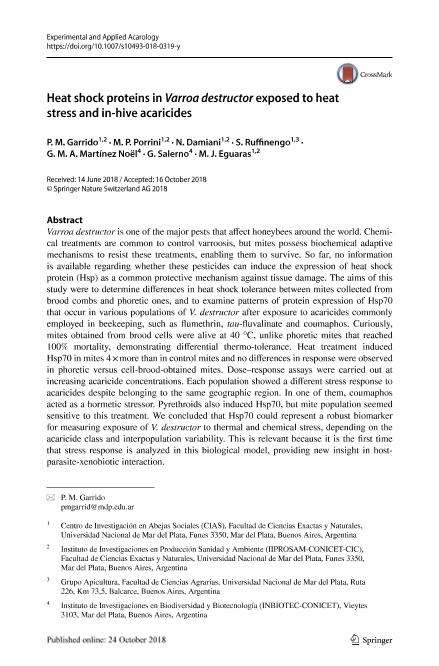Mostrar el registro sencillo del ítem
dc.contributor.author
Garrido, Paula Melisa

dc.contributor.author
Porrini, Martín Pablo

dc.contributor.author
Damiani, Natalia

dc.contributor.author
Ruffinengo, Sergio Roberto

dc.contributor.author
Martínez Noël, Giselle María Astrid

dc.contributor.author
Salerno, Graciela Lidia

dc.contributor.author
Eguaras, Martin Javier

dc.date.available
2019-11-08T13:13:28Z
dc.date.issued
2018-12
dc.identifier.citation
Garrido, Paula Melisa; Porrini, Martín Pablo; Damiani, Natalia; Ruffinengo, Sergio Roberto; Martínez Noël, Giselle María Astrid; et al.; Heat shock proteins in Varroa destructor exposed to heat stress and in-hive acaricides; Springer; Experimental and Applied Acarology; 76; 4; 12-2018; 421-433
dc.identifier.issn
0168-8162
dc.identifier.uri
http://hdl.handle.net/11336/88288
dc.description.abstract
Varroa destructor is one of the major pests that affect honeybees around the world. Chemical treatments are common to control varroosis, but mites possess biochemical adaptive mechanisms to resist these treatments, enabling them to survive. So far, no information is available regarding whether these pesticides can induce the expression of heat shock protein (Hsp) as a common protective mechanism against tissue damage. The aims of this study were to determine differences in heat shock tolerance between mites collected from brood combs and phoretic ones, and to examine patterns of protein expression of Hsp70 that occur in various populations of V. destructor after exposure to acaricides commonly employed in beekeeping, such as flumethrin, tau-fluvalinate and coumaphos. Curiously, mites obtained from brood cells were alive at 40 °C, unlike phoretic mites that reached 100% mortality, demonstrating differential thermo-tolerance. Heat treatment induced Hsp70 in mites 4 × more than in control mites and no differences in response were observed in phoretic versus cell-brood-obtained mites. Dose?response assays were carried out at increasing acaricide concentrations. Each population showed a different stress response to acaricides despite belonging to the same geographic region. In one of them, coumaphos acted as a hormetic stressor. Pyrethroids also induced Hsp70, but mite population seemed sensitive to this treatment. We concluded that Hsp70 could represent a robust biomarker for measuring exposure of V. destructor to thermal and chemical stress, depending on the acaricide class and interpopulation variability. This is relevant because it is the first time that stress response is analyzed in this biological model, providing new insight in host-parasite-xenobiotic interaction.
dc.format
application/pdf
dc.language.iso
eng
dc.publisher
Springer

dc.rights
info:eu-repo/semantics/openAccess
dc.rights.uri
https://creativecommons.org/licenses/by-nc-sa/2.5/ar/
dc.subject
HEAT SHOCK
dc.subject
HSP70 EXPRESSION
dc.subject
SYNTHETIC ACARICIDES
dc.subject
VARROA DESTRUCTOR
dc.subject.classification
Otras Ciencias Veterinarias

dc.subject.classification
Ciencias Veterinarias

dc.subject.classification
CIENCIAS AGRÍCOLAS

dc.subject.classification
Otras Ciencias Veterinarias

dc.subject.classification
Ciencias Veterinarias

dc.subject.classification
CIENCIAS AGRÍCOLAS

dc.title
Heat shock proteins in Varroa destructor exposed to heat stress and in-hive acaricides
dc.type
info:eu-repo/semantics/article
dc.type
info:ar-repo/semantics/artículo
dc.type
info:eu-repo/semantics/publishedVersion
dc.date.updated
2019-10-22T15:38:35Z
dc.journal.volume
76
dc.journal.number
4
dc.journal.pagination
421-433
dc.journal.pais
Alemania

dc.journal.ciudad
Berlin
dc.description.fil
Fil: Garrido, Paula Melisa. Universidad Nacional de Mar del Plata; Argentina
dc.description.fil
Fil: Porrini, Martín Pablo. Universidad Nacional de Mar del Plata; Argentina
dc.description.fil
Fil: Damiani, Natalia. Universidad Nacional de Mar del Plata; Argentina
dc.description.fil
Fil: Ruffinengo, Sergio Roberto. Universidad Nacional de Mar del Plata; Argentina
dc.description.fil
Fil: Martínez Noël, Giselle María Astrid. Consejo Nacional de Investigaciones Científicas y Técnicas. Centro Científico Tecnológico Conicet - Mar del Plata. Instituto de Investigaciones en Biodiversidad y Biotecnología; Argentina
dc.description.fil
Fil: Salerno, Graciela Lidia. Consejo Nacional de Investigaciones Científicas y Técnicas. Centro Científico Tecnológico Conicet - Mar del Plata. Instituto de Investigaciones en Biodiversidad y Biotecnología; Argentina. Fundación para Investigaciones Biológicas Aplicadas; Argentina
dc.description.fil
Fil: Eguaras, Martin Javier. Universidad Nacional de Mar del Plata; Argentina
dc.journal.title
Experimental and Applied Acarology

dc.relation.alternativeid
info:eu-repo/semantics/altIdentifier/url/http://link.springer.com/10.1007/s10493-018-0319-y
dc.relation.alternativeid
info:eu-repo/semantics/altIdentifier/doi/http://dx.doi.org/10.1007/s10493-018-0319-y
Archivos asociados
